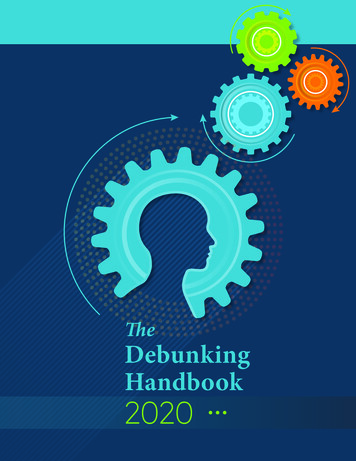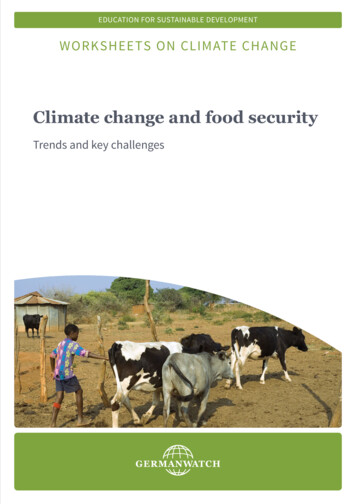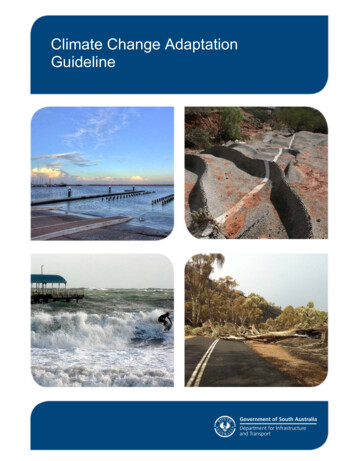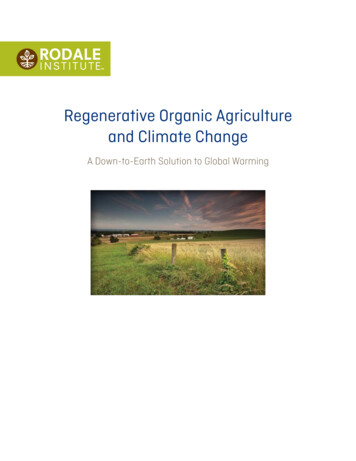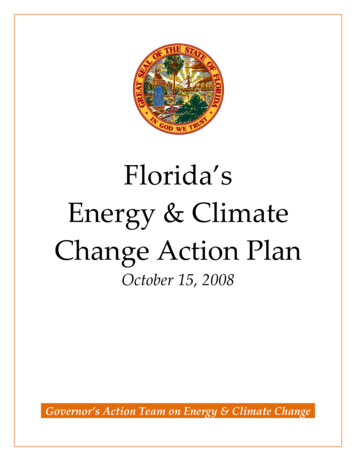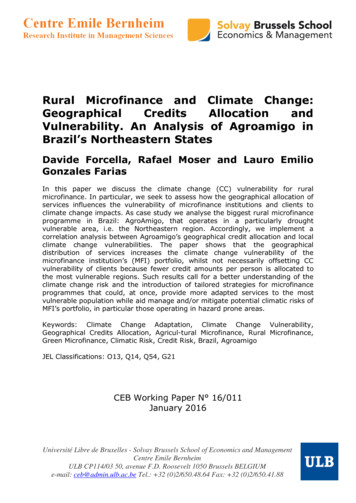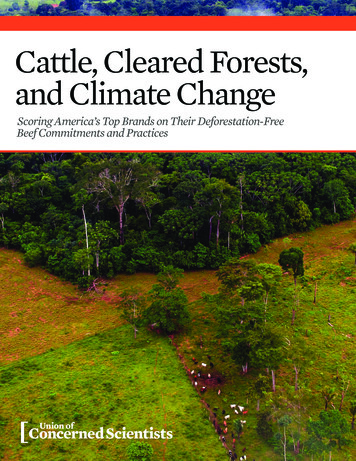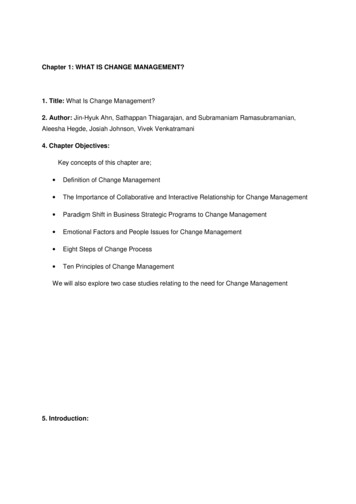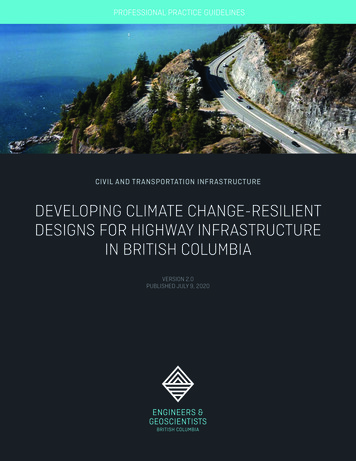
Transcription
PROFESSIONAL PRACTICE GUIDELINESCIVIL AND TRANSPORTATION INFRASTRUCTUREDEVELOPING CLIMATE CHANGE-RESILIENTDESIGNS FOR HIGHWAY INFRASTRUCTUREIN BRITISH COLUMBIAVERSION 2.0PUBLISHED JULY 9, 2020
FUNDING WAS PROVIDED BY:PROVINCE OF BCREVISED: VERSION 2.0, JULY 9, 2020FIRST PUBLISHED: VERSION 1.0, DECEMBER 2016 2020 ENGINEERS AND GEOSCIENTISTS BRITISH COLUMBIAALL RIGHTS RESERVED.COVER PHOTOGRAPH EB ADVENTURE PHOTOGRAPHY/SHUTTERSTOCK
PREFACEThese Professional Practice Guidelines – Developing The BCMoTI Design Criteria Sheet, the ClimateChange-Resilient Design Report (which can beincluded along with the Design Criteria Sheet asExplanatory Notes/Discussion), and the ClimateChange Risk Assessment Assurance Statement,which are to be used together, have beencombined into a single appendix (Appendix A). Descriptions of design strategies have been added,such as for the Observational Method and Low-orNo-Regret Strategies outlined in the AmericanSociety of Civil Engineers Manual of PracticeNo. 140 (Section 3.0: Guidelines for ProfessionalPractice).Climate Change-Resilient Designs for HighwayInfrastructure in British Columbia were developed byEngineers and Geoscientists British Columbia (theAssociation) to guide professional practice related toresilience, reliability, and sustainability of provincialhighway assets under changing climate conditions.These guidelines, which are modelled on the EngineersCanada Public Guideline: Principles of ClimateAdaptation and Mitigation for Engineers (EngineersCanada 2018), echo and elaborate on the BritishColumbia (BC) Ministry of Transportation andInfrastructure (BCMoTI) Technical Circular T-04/19,titled Resilient Infrastructure Engineering Design –Adaptation to the Impacts of Climate Change andWeather Extremes (BCMoTI 2019) (Appendix A).These guidelines further complement the Association’sProfessional Practice Guidelines – Legislated FloodAssessment Guidelines in a Changing Climate in BC(Engineers and Geoscientists BC 2018a). Theapplication of these guidelines is specific to HighwayInfrastructure owned by the BCMoTI.Specific factors addressed in these guidelines includehow extreme weather events are considered andincorporated into infrastructure design in projects.Examples provided in Section 7.0 Appendicesdemonstrate the use of climate projections along withengineering judgment in decision-making to promoteclimate change resilience.These guidelines were first published in 2016; thiscurrent version was revised in 2020 to include thefollowing: The updated BCMoTI Design Criteria Sheet forClimate Change Resilience from Technical-CircularT-04/19, which now includes the adaptation costestimate for BCMoTI Highway Infrastructureprojects (Appendix A.1).The Association provides various practice resourcesto its registrants to assist them in meeting theirprofessional and ethical obligations under theEngineers and Geoscientists Act. Among them areprofessional practice guidelines, which establish thestandard of practice for specific professional activities.These guidelines are not, in and of themselves,prescriptive design requirements, nor do theysupersede provisions specified by local governmentsand other approving bodies. Rather, these guidelinesestablish a common level of expectation for Clients,statutory decisionmakers, and Engineering/GeoscienceProfessionals who are addressing climate change andextreme weather events for BCMoTI highway designs.Where relevant, Engineering/Geoscience Professionalsare reminded to confirm the adequacy of their liabilityinsurance coverage when carrying out such work.These guidelines outline the appropriate standard ofpractice to be followed at the time they were prepared.However, this is a living document that is to be revisedand updated as required in the future, to reflect thedeveloping state of practice.PROFESSIONAL PRACTICE GUIDELINESDEVELOPING CLIMATE CHANGE-RESILIENT DESIGNS FOR HIGHWAY INFRASTRUCTURE IN BRITISH COLUMBIAVERSION 2.0i
TABLE OF CONTENTSPREFACEi3.2.3Identify Climate Parameters153.2.4Define Project Team and Identify Stakeholders 153.2.5Define Assessment Time HorizonABBREVIATIONSivDEFINED TERMSvVERSION HISTORYx3.3.1Define Objectives181.013.3.2Select Risk Assessment Method18Select Infrastructure Components20INTRODUCTION3.3CONDUCT THE CLIMATE CHANGE RISKASSESSMENT16171.1PURPOSE OF THESE GUIDELINES23.3.31.2ROLE OF ENGINEERS AND GEOSCIENTISTS BC23.3.4 Select and Define Specific Climate Parameters 211.3INTRODUCTION OF TERMS33.3.51.4SCOPE AND OVERVIEW OF THESE GUIDELINES 31.4.1Process and Outcomes3Identify and Characterize Infrastructure/ClimateInteractions223.3.6 Determine Climate Risk3.4IDENTIFY AND INCORPORATE ADAPTATIONMEASURES221.5APPLICABILITY OF THESE GUIDELINES51.6ACKNOWLEDGEMENTS53.4.1Exercise Professional Judgment271.7UPDATES TO THESE GUIDELINES63.4.2Identify Adaptation Options28ROLES AND RESPONSIBILITIES73.4.3 Communicate Effectively2.02.1COMMON FORMS OF PROJECT ORGANIZATION 72.2RESPONSIBILITIES726303.4.4 Finalize Adaptation Plan and Resilient DesignMeasures313.5DOCUMENT PROCESS AND DECISIONS312.2.1Client or Highway Infrastructure Owner92.2.2Engineer of Record92.2.3Qualified Professional102.2.4External Review of a Highway InfrastructureClimate Change-Resilient Design Report104.1.1Professional Practice Guidelines33GUIDELINES FOR PROFESSIONAL PRACTICE 114.1.2Use of Seal334.1.3Direct Supervision343.03.1OVERVIEW123.1.1Level of Effort and Detail123.1.2Summary of Roles and Responsibilities123.23.2.13.2.2DEFINE THE PROJECT12Characterize Project Location and IdentifyInfrastructure14Identify Non-Climate Design Drivers144.0QUALITY MANAGEMENT IN PROFESSIONALPRACTICE334.1QUALITY MANAGEMENT REQUIREMENTS4.1.4 Retention of Project Documentation4.1.5Documented Checks of Engineering andGeoscience Work4.1.6 Documented Field Reviews DuringImplementation or Construction4.1.733343435Documented Independent Review of StructuralDesigns35PROFESSIONAL PRACTICE GUIDELINESDEVELOPING CLIMATE CHANGE-RESILIENT DESIGNS FOR HIGHWAY INFRASTRUCTURE IN BRITISH COLUMBIAVERSION 2.0ii
5.0PROFESSIONAL REGISTRATION &EDUCATION, TRAINING, AND EXPERIENCE 365.1PROFESSIONAL REGISTRATION365.2EDUCATION, TRAINING, AND EXPERIENCE366.0REFERENCES AND RELATED DOCUMENTS386.1REFERENCES386.2RELATED DOCUMENTS407.0APPENDICES43LIST OF APPENDICESAppendix A: BCMoTI Design Criteria Sheet and Assurance Statement . 45Appendix B: Adaptation Examples from Practising Professionals . 63Appendix C: Climate Change Tools and Resources for Adaptation . 97Appendix D: List of Contributors . 99LIST OF FIGURESFigure 1: Summary Process for Climate Change-Resilient Design of Highway Infrastructure. 4Figure 2: Roles and Responsibilities of Professionals in Highway Infrastructure Projects . 8Figure 3: Roles, Responsibilities, and Processes of Carrying out Climate Change-Resilient Design of HighwayInfrastructure .13Figure 4: Sample Risk Matrix. 24LIST OF TABLESTable 1:Suggested Standard of Practice of a Qualified Professional Conducting a Climate ChangeRisk Assessment . 17PROFESSIONAL PRACTICE GUIDELINESDEVELOPING CLIMATE CHANGE-RESILIENT DESIGNS FOR HIGHWAY INFRASTRUCTURE IN BRITISH COLUMBIAVERSION 2.0iii
ABBREVIATIONSABBREVIATIONTERMACECAssociation of Consulting Engineering CompaniesACEC-BCAssociation of Consulting Engineering Companies British ColumbiaBCBritish ColumbiaBCMoTIBritish Columbia Ministry of Transportation and InfrastructureCPECoordinating Professional EngineerEOREngineer of RecordFHWA[US Department of Transportation] Federal Highway AdministrationGCMGlobal Climate ModelGHGGreenhouse GasQBSQualifications-Based SelectionQPQualified ProfessionalPCICPacific Climate Impacts ConsortiumPIEVCPublic Infrastructure Engineering Vulnerability CommitteeRCPRepresentative Concentration PathwaySRESSpecial Report on Emissions ScenariosVASTVulnerability Assessment Scoring ToolPROFESSIONAL PRACTICE GUIDELINESDEVELOPING CLIMATE CHANGE-RESILIENT DESIGNS FOR HIGHWAY INFRASTRUCTURE IN BRITISH COLUMBIAVERSION 2.0iv
DEFINED TERMSThe following definitions are specific to these guidelines. These words and terms are capitalized throughoutthe document.TERMDEFINITIONActEngineers and Geoscientists Act [RSBC 1996], Chapter 116.Adaptation Measure(s)Actions that reduce the Vulnerability of Highway Infrastructure to the impacts ofclimate change by reducing the likelihood and/or consequences of failure. Thesemay also include other infrastructure designed to reduce or deflect loads on theprimary infrastructure, policies or infrastructure designed to reduce theconsequences of failure, increased monitoring, and increased or differentmaintenance procedures.AgreementA formal written or verbal contract or terms of engagement between the Client andthe Engineer of Record, or his or her company, for carrying out Climate ChangeResilient Design of Highway Infrastructure. This may also refer to a formal writtenor verbal contract or terms of engagement between the Qualified Professional ortheir company and the Engineer of Record or the Client, for conducting a ClimateChange Risk Assessment of new or existing Highway Infrastructure.AssociationThe Association of Professional Engineers and Geoscientists of the Province ofBritish Columbia, also operating as Engineers and Geoscientists BC.Assurance StatementSee the definition for Climate Change Risk Assessment Assurance Statement.BCMoTI Design Criteria Sheet forClimate Change Resilience(BCMoTI Design Criteria Sheet)The form that engineers working on Highway Infrastructure design projects underthe ownership of the BCMoTI are required to complete.The BCMoTI Design Criteria Sheet documents how engineers used their engineeringjudgment to incorporate consideration of climate change into the appropriatedesign components of the Highway Infrastructure.The form is completed by the Engineering Professional overseeing the design of theHighway Infrastructure, who is referred to in these guidelines as the Engineer ofRecord or, for large projects with multiple Engineers of Record, the CoordinatingProfessional Engineer.BylawsThe Bylaws of the Association made under the Act.ClientTypically, the Client is the BCMoTI, who is also the Owner, or a third partycontracted to maintain or design the Highway Infrastructure on behalf ofthe BCMoTI.The individual or company working on a BCMoTI project engages an Engineer ofRecord to carry out Resilient Design of new or existing Highway Infrastructure.In some cases, the Client may also engage a Qualified Professional to conduct aClimate Change Risk Assessment.PROFESSIONAL PRACTICE GUIDELINESDEVELOPING CLIMATE CHANGE-RESILIENT DESIGNS FOR HIGHWAY INFRASTRUCTURE IN BRITISH COLUMBIAVERSION 2.0v
TERMDEFINITIONClimate Change Information PortalAn online information portal developed by the Association that provides access toclimate change adaptation tools and resources to help Engineering Professionalsincorporate considerations of climate change into their practice(egbc.ca/climateportal). The information accessed through this portal complementsthe guidance provided in these guidelines.Climate Change ResilienceThe end result of facilitating the modification, renewal, or renovation of a particularpiece of infrastructure, such that its ability to recover from a climate impact isachieved through resistance to failure, swiftness with which functionality is reestablished, and reliability of service.Climate Change Resilience is often achieved by using Flexible Design strategies,the goal of which is to avoid committing to a specific course of action, or fullybuilding for future conditions in the present, so as not to unreasonably limit optionsavailable in the future to address changing conditions. Examples are securingsufficient right-of-way to allow for future dike raising when necessary, or increasingthe size of a culvert so that established design criteria are met during any futureextreme-weather events.As some infrastructure may inevitably require periodic renewal or replacement ofcomponents, Climate Change Resilience can be relatively easily included as ameasure to address climate change for these projects.Climate Change Risk Assessment(Risk Assessment)An assessment that involves investigations to determine the risk to the HighwayInfrastructure under consideration due to climate change, supported with anappropriate level of analysis and professional engineering and professionalgeoscience interpretation. The Climate Change Risk Assessment is conducted by aQualified Professional; however, it may also be conducted by an Engineer of Recordwith the appropriate expertise.The Public Infrastructure Engineering Vulnerability Committee (PIEVC) EngineeringProtocol is a risk assessment method that has been successfully applied to a widerange of public infrastructure projects in Canada and internationally (PIEVC 2020).The ISO 31000 Risk Management standard may be used in the absence of amethodology that follows the PIEVC Engineering Protocol.Climate Change Risk AssessmentAssurance Statement(Assurance Statement)A statement signed and sealed by a Qualified Professional or the Engineer of Recordthat provides assurance that these guidelines were applied when completing theClimate Change Risk Assessment (see Appendix A).A Qualified Professional or the Engineer of Record prepares the AssuranceStatement and provides it to the Owner.Climate RiskThe level of a negative impact due to a change in climate. Risk is a function of thelikelihood of the climate event and the severity of its consequence. In the ClimateChange Risk Assessment, risk is a measure of the level of Vulnerability of theinfrastructure to the effects of climate change.Climate Risk ToleranceThe level of climate change-related risk that the Owner is willing to accept inconsideration of a given Highway Infrastructure. It typically depends on thefunctions and design life of the infrastructure.The PIEVC Engineering Protocol directs the practitioner to confirm theinfrastructure Owner’s risk tolerance thresholds prior to conducting the ClimateChange Risk Assessment. The PIEVC Engineering Protocol suggests high, medium,and low risk thresholds.PROFESSIONAL PRACTICE GUIDELINESDEVELOPING CLIMATE CHANGE-RESILIENT DESIGNS FOR HIGHWAY INFRASTRUCTURE IN BRITISH COLUMBIAVERSION 2.0vi
TERMDEFINITIONClimate SpecialistA specialist who studies long-term weather patterns and the processes that causethem. Climate Specialists use long-term meteorological data to study trends inweather patterns, understand their causes, and make predictions.In the context of these guidelines, a Climate Specialist is a professional who,through their expertise and qualifications, assists the Qualified Professional inconducting the Climate Change Risk Assessment, by providing projections of futureclimate for the region under consideration.A Climate Specialist may also assist the Qualified Professional in understandingwhat climate parameters need to be considered, by defining climate thresholds forHighway Infrastructure failure and identifying some of the likely impacts of futureclimate conditions on the Highway Infrastructure under consideration.Coordinating Professional Engineer(CPE)An Engineering Professional who is responsible for coordinating the design of alarge project, and for overseeing multiple Engineers of Record who are responsiblefor different aspects of the ssional engineers, professional geoscientists, and licensees, who areregistered or licensed by the Association and entitled under the Act to engage in thepractice of professional engineering or professional geoscience in British Columbia.In relation to Highway Infrastructure design: an Engineering Professional is typically registered in the disciplines of civil(geotechnical, structural, hydrotechnical), mechanical, or electrical engineering,or other disciplines with scopes of practice that contribute to infrastructuredesign; and a Geoscience Professional is typically registered in the disciplines of geology orenvironmental geoscience, or other disciplines with scopes of practice thatcontribute to infrastructure design.Engineers and Geoscientists BCThe business name for the Association.Engineer of Record (EOR)An Engineering Professional within a design firm who is responsible for design ofspecific portions of a project (e.g., geotechnical, hydrotechnical, structural, or civil)and assumes professional responsibility for that portion. An Engineer of Record withthe appropriate expertise may also act in the capacity of the Qualified Professionaland take responsibility for the Climate Change Risk Assessment.Flexible DesignHighway Infrastructure with Flexible Design has the capacity for components of thedesign to be changed in the future. Flexible Design may include redundant systemsor the ability for the size or functions of design components to be changed in thefuture. (The term “adaptive design” is synonymous with “Flexible Design.”)Highway InfrastructureInfrastructure under the ownership of the BCMoTI. Examples of HighwayInfrastructure include, but are not limited to bridges, interchanges, junctions,tunnels, and structures that cross streams, pavements, embankments, ditches,engineering stabilization works, retaining walls, pavements, drainage appliances,and roads.PROFESSIONAL PRACTICE GUIDELINESDEVELOPING CLIMATE CHANGE-RESILIENT DESIGNS FOR HIGHWAY INFRASTRUCTURE IN BRITISH COLUMBIAVERSION 2.0vii
TERMDEFINITIONHighway InfrastructureClimate Change-Resilient DesignReportA document that includes the details of the Screening-Level Risk Assessment,Climate Change Risk Assessment, engineering analysis, development of climatechange-resilient design criteria, and conclusions and recommendations provided bythe Qualified Professional with regard to designing for climate change adaptation.The Highway Infrastructure Climate Change-Resilient Design Report must beprovided to the Owner in conjunction with the Climate Change Risk AssessmentAssurance Statement (see Appendix A).Low-or-No-Regret StrategiesStrategies that offer co-benefits under a range of climate change scenarios in thepresent, and lay the foundation for addressing projected changes in the future(IPCC 2012).MitigationMeasures that reduce the emissions of greenhouse gases that drive climate change,which include, but are not limited to, use of renewable energy, improved energyefficiency, reduced energy use, or reductions in embedded energy in materials orproducts.Observational MethodA continuous, managed, integrated, robust, on-the-ground engineering process ofdesign, construction control, monitoring, and review that enables previously definedmodifications to be incorporated during or after construction, as appropriate. Theobjective is to achieve greater overall economy without compromising safety(ASCE 2018).OwnerThe BC Ministry of Transportation and Infrastructure. For most HighwayInfrastructure projects, the Owner is also the Client (see definition of Client).Qualified Professional (QP)An Engineering/Geoscience Professional with the appropriate knowledge andexperience to carry out a Climate Change Risk Assessment, .The Qualified Pro
insurance coverage when carrying out such work. These guidelines outline the appropriate standard of practice to be followed at the time they were prepared. However, this is a living document that is to be revised and updated as required in the future, to reflect the developing state of practice.


